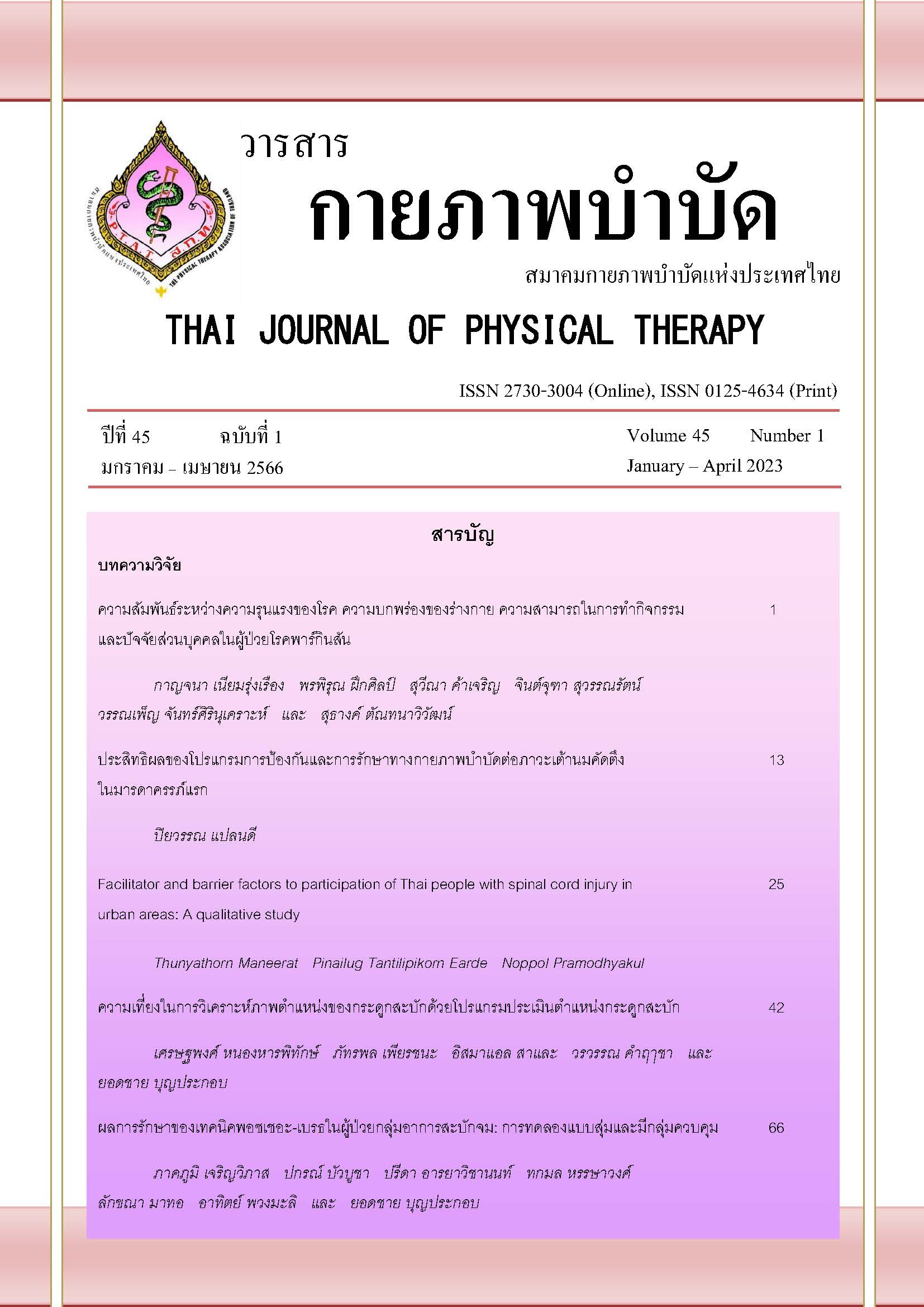ความเที่ยงในการวิเคราะห์ภาพตำแหน่งของกระดูกสะบักด้วยโปรแกรมประเมินตำแหน่งกระดูกสะบัก
Main Article Content
บทคัดย่อ
ที่มาและความสำคัญ: ในปัจจุบันมีเครื่องมือที่ใช้ในการประเมินตำแหน่งการวางตัวของกระดูกสะบักมากมาย อย่างไรก็ตาม เครื่องมือหรือวิธีการประเมินเหล่านั้นยังคงมีข้อจำกัดในด้านต่าง ๆ โปรแกรมประเมินตำแหน่งกระดูกสะบักจึงถูกพัฒนาขึ้นเพื่อวิเคราะห์ตำแหน่งกระดูกสะบักในหลายระนาบการเคลื่อนไหว เนื่องจากเป็นโปรแกรมที่พัฒนาขึ้นเป็นครั้งแรกและยังไม่มีข้อมูลเกี่ยวกับความเที่ยงของผู้วัด การศึกษาเพื่อให้ทราบถึงความเที่ยงของผู้วัดจึงมีความสำคัญ
วัตถุประสงค์: เพื่อศึกษาความเที่ยงภายในและระหว่างผู้วัดในการวิเคราะห์ตำแหน่งของกระดูกสะบักด้วยโปรแกรมประเมินตำแหน่งกระดูกสะบัก
วิธีการวิจัย: อาสาสมัครสุขภาพดี จำนวน 33 คน ได้รับการประเมินตำแหน่งกระดูกสะบักจากผู้วัด 2 คน ที่มีประสบการณ์ทางคลินิกแตกต่างกัน ตัวแปรที่ใช้ประเมินได้แก่ ระยะทางระหว่างมุมด้านล่างของกระดูกสะบักกับแนวกึ่งกลางลำตัว ระยะทางระหว่าง root of spine ของกระดูกสะบักกับแนวกึ่งกลางลำตัว มุมการหมุนขึ้นของกระดูกสะบัก มุมการเคลื่อนขึ้นของกระดูกสะบัก และมุมการหมุนออกของกระดูกสะบัก จากนั้นนำข้อมูลความเที่ยงภายในผู้วัดมาทดสอบด้วยสถิติสัมประสิทธิ์สหสัมพันธ์ภายในชั้นแบบ 3, 2 (Intraclass correlation coefficient; ICC3, 2) และนำข้อมูลความเที่ยงระหว่างผู้วัดมาทดสอบด้วยสถิติสัมประสิทธิ์สหสัมพันธ์ภายในชั้นแบบ 2, 2 (Intraclass correlation coefficient; ICC2, 2)
ผลการวิจัย: ความเที่ยงภายในผู้วัดที่มีประสบการณ์ทางคลินิกอยู่ในระดับสูง มีค่า ICC3, 2 ระหว่าง 0.77 ถึง 0.98 ในขณะที่ความเที่ยงภายในผู้วัดที่เป็นนักศึกษากายภาพบำบัดชั้นปีที่ 4 อยู่ในระดับปานกลางถึงสูง มีค่า ICC3, 2ระหว่าง 0.68 ถึง 0.97 และความเที่ยงระหว่างผู้วัดอยู่ในระดับปานกลางถึงสูง มีค่า ICC2, 2 ระหว่าง 0.60 ถึง 0.92
สรุปผล: ผลการศึกษาครั้งนี้แสดงให้เห็นว่าความเที่ยงภายในผู้วัดในการใช้โปรแกรมประเมินตำแหน่งกระดูกสะบักในผู้วัดที่มีประสบการณ์มีค่าระดับสูง ในขณะที่ความเที่ยงระหว่างผู้วัดมีค่าระดับปานกลางถึงสูง ดังนั้น ก่อนใช้โปรแกรมประเมินตำแหน่งกระดูกสะบัก ผู้วัดควรได้รับการฝึกฝนภายใต้คำแนะนำจากผู้เชี่ยวชาญและมีประสบการณ์ รวมถึงฝึกซ้อมให้แม่นยำก่อนดำเนินการประเมินต่อไป นอกจากนี้ การศึกษาในอนาคตควรทดสอบความเที่ยงของผู้วัดในผู้ที่มีปัญหาการวางตัวของตำแหน่งกระดูกสะบักเพื่อให้ทราบถึงข้อมูลความเที่ยงเพื่อนำไปใช้ในกลุ่มประชากรที่หลากหลายต่อไป
Article Details

อนุญาตภายใต้เงื่อนไข Creative Commons Attribution-NonCommercial-NoDerivatives 4.0 International License.
เอกสารอ้างอิง
Matsui K, Tachibana T, Nobuhara K, Uchiyama Y. Translational movement within the glenohumeral joint at different rotation velocities as seen by cine MRI. J Exp Orthop 2018; 5: 7. doi: 10.1186/s40634-018-0124-x.
McQuade KJ, Borstad J, de Oliveira AS. Critical and Theoretical Perspective on Scapular Stabilization: What Does It Really Mean, and Are We on the Right Track? Phys Ther 2016; 96(8): 1162-9. doi: 10.2522/ptj. 20140230.
McClure PW, Michener LA, Sennett BJ, KardunaDirect AR. 3-dimensional measurement of scapular kinematics during dynamic movements in vivo. J Shoulder Elbow Surg 2001; 10(3): 269-77. doi: 10.1067/mse. 2001.112954.
Panagiotopoulos AC, Crowther IM. Scapular dyskinesia, the forgotten culprit of shoulder pain and how to rehabilitate. SICOT J 2019; 5: 29. doi: 10.1051/sicotj/2019029.
Ludewig PM, Reynolds JF. The association of scapular kinematics and glenohumeral joint pathologies. J Orthop Sports Phys Ther 2009; 39(2): 90-104. doi: 10.2519/jospt.2009.2808.
Struyf F, Nijs J, Baeyens JP, Mottram S, Meeusen R. Scapular positioning and movement in unimpaired shoulders, shoulder impingement syndrome, and glenohumeral instability. Scand J Med Sci Sports 2011; 21(3): 352-8. doi: 10.1111/j.1600-0838. 2010.01274.x.
Burn MB, McCulloch PC, Lintner DM, Liberman SR, Harris JD. Prevalence of Scapular Dyskinesis in Overhead and Nonoverhead Athletes: A Systematic Review. Orthop J Sports Med 2016; 17; 4(2): 2325967115627608. doi: 10.1177/2325967115627608.
Larsen CM, Søgaard K, Eshoj H, Ingwersen K, Juul-Kristensen B. Clinical assessment methods for scapular position and function. An inter-rater reliability study. Physiother Theory Pract 2020; 36(12): 1399-420. doi: 10.1080/ 09593985.2019.1579284.
Park JY, Hwang JT, Kim KM, Makkar D, Moon SG, Han KJ. How to assess scapular dyskinesis precisely: 3-dimensional wing computer tomography--a new diagnostic modality. J Shoulder Elbow Surg 2013; 22(8): 1084-91. doi: 10.1016/j.jse.2012.10.046.
Jildeh TR, Ference DA, Abbas MJ, Jiang EX, Okoroha KR. Scapulothoracic Dyskinesis: A Concept Review. Curr Rev Musculoskelet Med 2021; 14(3): 246-54. doi: 10.1007/s12178-021-09705-8.
Walter SD, Eliasziw M, Donner A. Sample size and optimal designs for reliability studies. Stat Med 1998; 17(1): 101-10. doi:10.1002/(sici)1097-0258(19980115)17:1<101::aid-sim727>3.0.co;2-e.
Sanchez HM, Sanchez EG, Tavares LI. Association between scapular dyskinesia and shoulder pain in young adults. Acta Ortop Bras 2016; 24(5): 243-8. doi: 10.1590/1413-785220162405142225.
Portney LG, Watkins MP. Foundations of clinical research applications to practice. New Jersey: Prentice Hall Inc; 2000; 560-7.
Hopkins WG. Measures of reliability in sports medicine and science. Sports Med 2000; 30: 1-15.doi:10.2165/00007256-200030010-00001.
Kawsoiy K, Uthaikhup S. Intra-and inter-rater reliability of ultrasound imaging of the lower trapezius muscle thickness. J Med Tech Phy Ther 2014; 26: 180-8.
Liaw LJ, Hsieh CL, Lo SK, Chen HM, Lee S, Lin JH. The relative and absolute reliability of two balance performance measures in chron- ic stroke patients. Disabil Rehabil 2008; 30(9): 656-61. doi: 10.1080/09638280701400698.
Juul-Kristensen B, Hilt K, Enoch F, Remvig L, Sjøgaard G. Scapular dyskinesis in trapezius myalgia and intraexaminer reproducibility of clinical tests. Physiother Theory Pract 2011; 27(7): 492-502. doi: 10.3109/09593985.2010.528548.
Lewis JS, Valentine RE. Intraobserver reliability of angu- lar and linear measurements of scapular position in subjects with and without symptoms. Arch Phys Med Rehabil 2008; 89(9): 1795-802. doi: 10.1016/j.apmr.2008.01.028.
Kibler WB. The role of the scapula in athletic shoulder function. Am J Sports Med 1998; 26(2): 325-37. doi: 10.1177/ 03635465980260022801.
De Groef A, Van Kampen M, Vervloesem N, Clabau E, Christiaens M, Neven P, et al. Inter-rater reliability of shoulder measurements in middle-aged women. Physiotherapy 2017. 103: 222-30. doi: 10.1016/j.physio.2016.07.002.
Watson L, Balster S, Finch C, Dalziel. Measurement of scapula upward rotation: A reliable clinical procedure. Br J Sports Med 2005; 39(9): 599-603. doi: 10.1136/ bjsm.2004.013243.
Michener LA, Elmore KA, Darter BJ, Timmons MK. Biomechanical measures in participants with shoulder pain: Intra-rater reliability. Man Ther 2016; 22: 86-93. doi: 10.1016/j.math.2015.10.011.


